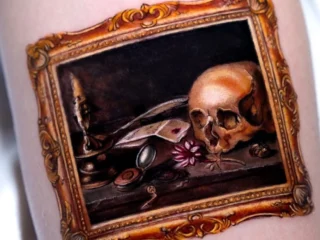Devon Preston
October 18th, 2018
Your Ultimate Guide For Removing a Tattoo
Want a Tattoo Removed? We've Got You Covered!
If you have a tattoo that you want gone for good, listen up. We’re going to be hashing out the dos and don’ts of tattoo removal once and for all, to ensure that our readers have a successful experience lightening their regrettable ink. Of course, laser tattoo removal is only one of the options available for getting rid of a tattoo, however, most experts will say that it is the most effective method on the market. Why is this the case? Well, the laser is the only way to permanently lighten a tattoo in this day and age. Many companies have tried to release tattoo removal creams, but we’ve yet to come across one that actually does the job. Laser tattoo removal is increasingly becoming more accessible to clients around the world and there are plenty of photographs online that celebrate its results.
Yet, many of you may be wondering where the hell to begin with this process. Well, its time you learned from the tattoo experts at INKED and hopefully, by the end of this article, you have a better idea of how the procedure goes down.

The first step of laser tattoo removal often comes as the most challenging and its finding a facility that offers these services. Although laser tattoo removal is becoming more common, many people live in areas where it is not readily available. However, the best way in 2018 to find out if there is a clinic around you is to do your research. The internet is a great way to find out if there are specialists who offer laser removal near you and many, if not all, have reviews from real customers. Another great way to find out about laser tattoo removal in your area is to ask a local tattooer, as many of them might be able to recommend a specialist nearby.

Once you have found a laser removal tattoo technician in your area, its time to book an appointment. Unlike tattooing, there are a lot of variabilities when it comes to tattoo removal and specialists will need to go through an individualized approach for every client that comes through the door. This is because every tattoo is unique in the colors that are used, how saturated the blacks are, how it was applied and how long it has sat in the skin. Not to mention, skin tone and type play a huge role in the process as well. Generally, most laser removal technicians will have prospective clients send photos and a brief description of the tattoo before the appointment is booked. Then, once they are in the office and ready to undergo their first session, they are evaluated in person. There is a lot of time and energy put into this process because a person’s tattoo and their skin type will determine how strong the technician can turn up the laser. If the laser is turned up too high, the patient can have permanent scarring and no one wants that on top of a tattoo they want to be removed.

One of the biggest misconceptions that people have about tattoo removal has to do with the number of sessions that a client has. Some people go into the experience thinking that tattoo removal is one and done, however, this is most often not the case. There are many of different factors that go into how many sessions a person will need and a technician is only able to give a rough estimate. This is because they do not know how the patient will heal and how the tattoo will react to the laser. Some people only need a couple of sessions, while others may have to have 10-20 sessions in order to completely remove a tattoo. It’s all relative and laser removal technicians cannot predict the future.

Another misconception that people have about tattoo removal has to do with the process itself. I can’t tell you how many times people checked out my tattoo after one session of laser and said, “Hey, I thought you had that removed?” The thing is, tattoo removal is slow and gradual, with tattoos lightening up slightly over three months between sessions. This is because the laser works by breaking up the tattoo particles under the skin and allowing the body to absorb then flush out the tattoo. From the moment your tattoo is put into your skin until the day you die, your body responds to your tattoo as a foreign object and slowly breaks it down. This is why tattoos age and fade over time, with some styles that aren’t saturated with black fading quicker than others. The laser simply speeds up the bodies’ natural process of removing a tattoo.

Now that you understand how the lasers work, you may come across many companies offering different types of machines. Q-Switch lasers were first developed in the 1980s and for almost 40 years, they’ve been considered the most popular and most effective technologies for removing tattoos. However, in 2018, a laser called the PicoSure was released that may have previous machines beat. While Q-Switch lasers emit energy in millionths of a second, this laser emits them in trillionths of a second. This makes the process more effective for each session so that clients can get their tattoo removed sooner and safer.

Now, you’ve probably been asking yourself—”Does tattoo removal hurt?” And unfortunately, we have to admit that it does. Like getting a tattoo, tattoo removal os anything but pain-free—however, these experiences are vastly different. First off, the sensation of laser removal is extremely unique and can be attributed to a hot/burning feeling. Whereas, if you have a tattoo, you will recognize the dull scratching sensation of a group of small needles. The feeling or pain of tattoo removal is often described as being more intense than the tattoo process, but the procedure itself takes way less time. While some tattoos can take hours to complete, most laser removal sessions only last a couple of minutes. I am currently in the middle of having a small word removed from my chest and I don’t have to endure the pain for longer than 30 seconds at a time.

Now, its time to talk about healing. Many of you have probably seen the aftermath of a tattoo that has been removed—which features a thin whitish scab. However, the process of healing a removed tattoo is almost identical to that of a fresh tattoo. After your session of the laser is complete, your technician is going to wrap up the tattoo in order to keep it protected. Then, after a few hours, you will be able to remove the bandage and treat the piece like a fresh tattoo by applying thin layers of unscented moisturizer. It will take a week or two for the scabs to heal and as always, don’t pick at it! Most technicians recommend that patients wait between 6 weeks and three months between sessions, in order for the body to begin breaking down the ink pigments. This time allows your specialist to see how your body reacts to the laser so that they know how to approach the following sessions.

Okay, you’ve probably heard some horror stories about tattoo removal, but its time we debunked some myths. Blistering and scabbing are totally normal to the laser removal process, but these symptoms should be temporary. If the blisters cause you extreme pain and leave you with permanent scars, something went wrong. There are a couple of factors that come into play when a tattoo removal goes wrong and the first occurs when people try being creative or cheap with an at home removal solution. Believe it or not, but many people have risked their lives in order to remove a tattoo at home and almost all suffer permanent damage to their skin. Some of these methods, which we do not condone, include using black market tattoo removal products, chemical peels or lactic acid injections. In other cases, a disaster occurs when a client doesn’t do the proper research when finding a technician. Cheap machines and inexperienced technicians can cause lasting damage to a tattoo, therefore it pays, in the long run, to go to an experienced professional. Getting a bad tattoo is one thing because in most cases it can be covered or removed. But getting a bad laser procedure can be almost impossible to fix.

Another factor that comes into play during the tattoo removal process is the price. Unless you’re a very special circumstance, removal will cost a couple hundred dollars to several thousand from start to finish. The amount of money that you will need to invest depends on a couple factors, with the first being how many sessions you’ll need to have in order to remove the tattoo. If you’re lasering your tattoo for a coverup, you shouldn’t need more than a few sessions. However, as we’ve mentioned before, this all depends on the individual. Budgeting for your tattoo removal process is essential and the amount per session will depend on where you go. But again, please don’t put yourself into harm’s way in order to get a tattoo removed cheaper. In the long run, you’d probably end up spending more to fix the removal than if you’d gone to a qualified professional in the first place.

Now that you’ve learned how the process works, how to find a technician and what to expect from the experience you’re ready to start your journey. I know, the process may seem daunting when it is all laid out in front of you, but we promise that it’s totally worth it. You wouldn’t believe the effect a tattoo can have on a person’s self-esteem and the real damage it can do to both their personal and professional lives. But in 2018, we live in an age where tattoos aren’t permanent and people are truly given second chances. I know that I can’t wait until my tattoo is gone for good and I have the chance to go to the artist of my dreams to give me the piece that should have been there all along. That’s the thing though, I probably would have never known what I’d want my fresh start tattoo to be if I hadn’t gone through getting a bad tattoo in the first place. And while tattoo removal technology is constantly evolving and this guide will probably be out of date by the time I press publish, it’s important for our audience to understand and evaluate the options available to them. So what are you doing living another day with a tattoo that you hate? Why not get the show in motion and start your search while the iron is hot? And if you’re currently in the process of removing a tattoo or have already finished the journey—let us know your thoughts in the comments section on Facebook.
Editor's Picks
Chris Brown’s Face Tattoo Shows His Heart and Sole
Chris Brown has a brand new tattoo! Long gone are the days of the baby faced teen, Brown is all grown up and has the tattoo collection to prove it!…
Oh Me, Oh My
Chrissy Chlapecka on finding her voice, spreading self-love on TikTok and releasing her first single













